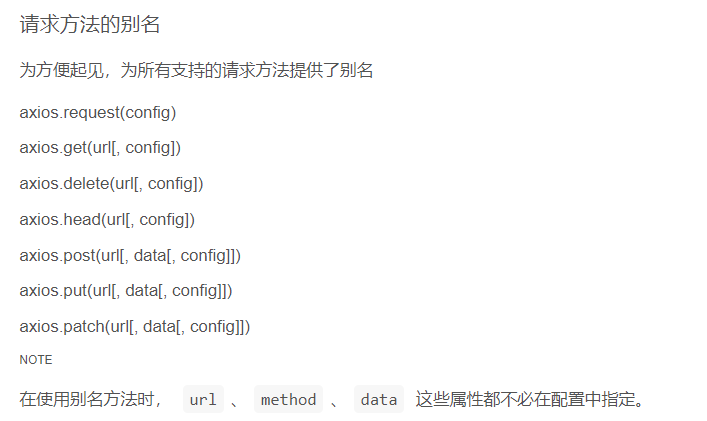
Axios 是由原生的XMLRequest和Priomse相结合的http库,进行对数据的请求等操作 。
安装:
npm install axios
使用:
Get:
axios.get('/user', {
params: { //连接参数
ID: 12345
}
})
.then(function (response) {
console.log(response);
})
.catch(function (error) {
console.log(error);
});
Post:
axios.post('/user', { //提交的数据
firstName: 'Fred',
lastName: 'Flintstone'
})
.then(function (response) {
console.log(response);
})
.catch(function (error) {
console.log(error);
});
多个请求并发的时候:
axios.all([getUserAccount(), getUserPermissions()]) //和Promise基本相同 .then(axios.spread(function (acct, perms) { // 两个请求现在都执行完成 }));

axios的config参数:
const config = { url:"/user", //数据地址 method:"get", //请求方式 baseURL : "http://smome-domain.com/api/",//将baseURL自动添加到url之前,兴程绝对的URL transformRequest:[ //允许在向服务器发送前修改数据,只能用在PUT,POST ,PATCH这几个请求方法中 //后面数组中的函数必须返回一个字符串或是数据流 function(data){ return data; } ], transformResponse:[ //在传递给then或是catch之前,允许对响应数据进行修改 function(data){ //对数据进行转化 return data; } ], //自定义请求头 headers:{"X-Requested-With": "XMLHttpRequest"}, //请求发送的数据 必须是一个无格式对象 params:{ ID:1235 }, //负责 params序列化的函数 paramsSerializer:function(params){ // .... }, //作为请求主体被发送的数据 只适用于PUT POST PATCH data:{ fistrName:"zzz" }, //超时时间 timeout:1000, //表示跨域请求时是否需要使用凭证 withCredentials:false ,//默认的 //允许自定义处理请求,以使测试更轻松 返回以恶搞有效的响应 adapter:function(config){ //... }, //http的基础验证 auth:{ usename:'...', password:'....' }, //服务器响应的数据类型 responseType:"json", //xsrf token 的值的HTTP头的名称 xsfHeaderName:'X_XSRF-TOKEN', //作用 xsrf token的值的cookie名称 xsrfCookieName:'XSRF_TOKEN', //允许上传处理进度事件 onUploadProgress:function(progressEvent){}, //允许为下载处理进度事件 onDownloadPeogress:function(){}, maxContentLength:2000, //允许响应头内容的最大尺寸 validStatus:function(){} ,//定义对于给定的HTTP的响应状态码是 resolve /reject //follow的最大重定数目 maxRedirects:5, // `httpAgent` 和 `httpsAgent` 分别在 node.js 中用于定义在执行 http 和 https 时使用的自定义代理。允许像这样配置选项: // `keepAlive` 默认没有启用 httpAgent: new http.Agent({ keepAlive: true }), httpsAgent: new https.Agent({ keepAlive: true }), // "proxy" 定义代理服务器的主机名称和端口 // `auth` 表示 HTTP 基础验证应当用于连接代理,并提供凭据 // 这将会设置一个 `Proxy-Authorization` 头,覆写掉已有的通过使用 `header` 设置的自定义 `Proxy-Authorization` 头。 proxy: { host: "127.0.0.1", port: 9000, auth: { username: "mikeymike", password: "rapunz3l" } }, // `cancelToken` 指定用于取消请求的 cancel token // (查看后面的 Cancellation 这节了解更多) cancelToken: new CancelToken(function (cancel) { }) }